The Largest Geodetic Coseismic Assessment of the 2020 Mw = 6.4 Petrinja Earthquake
Abstract
1. Introduction
2. Geological Observations
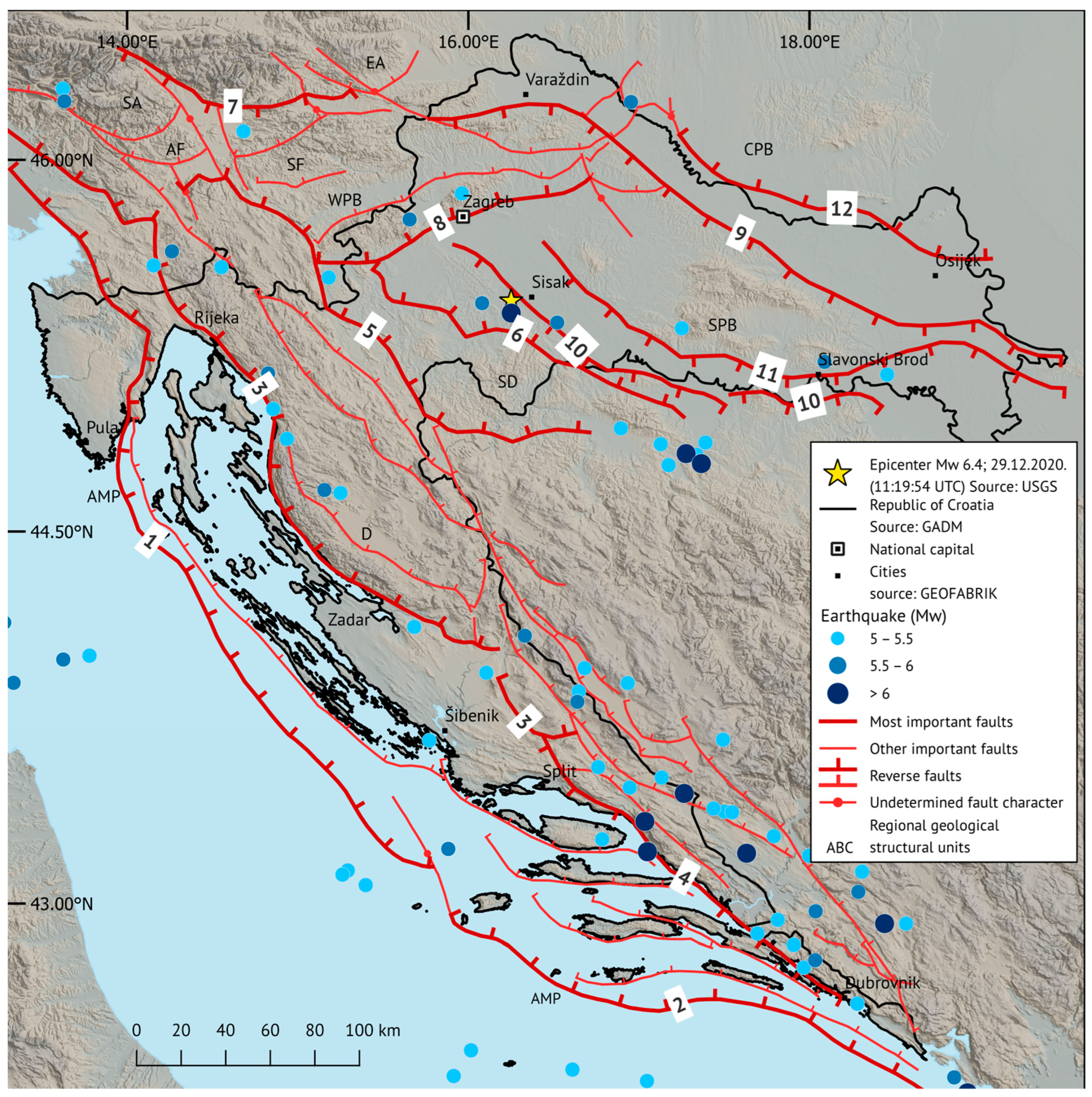
3. Study Area and Data
4. Geodetic Coseismic Observations
4.1. DInSAR Processing
4.2. GNSS Processing
5. Discussion
6. Conclusions
Author Contributions
Funding
Data Availability Statement
Acknowledgments
Conflicts of Interest
References
- Kozák, J.; Čermák, V. Zagreb (Agram) Earthquake, Croatia, 1880. In The Illustrated History of Natural Disasters; Springer: Dordrecht, The Netherlands, 2010; pp. 151–153. [Google Scholar] [CrossRef]
- Grenerczy, G.; Kenyeres, A.; Fejes, I. Present crustal movement and strain distribution in Central Europe inferred from GPS measurement. J. Geophys. Res. 2000, 105, 21835–21846. [Google Scholar] [CrossRef]
- Grenerczy, G.; Sella, G.; Kenyeres, A. Tectonic implications of the GPS velocity field in the northern Adriatic region. Geophys. Res. Lett. 2005, 32, 1–4. [Google Scholar] [CrossRef]
- Bada, G.; Grenerczy, G.; Tóth, L.; Horváth, F.; Stein, S.; Cloetingh, S.; Windhoffer, G.; Fodor, L.; Pinter, N.; Fejes, I. Motion of Adria and ongoing inversion of the Pannonian Basin: Seismicity, GPS velocities, and stress transfer. In Continental Intraplate Earthquakes: Science, Hazard, and Policy Issues; Geological Society of America: Boulder, CO, USA, 2007; pp. 243–262. [Google Scholar] [CrossRef]
- Kearey, P.; Klepeis, K.A.; Vine, F.J. Global Tectonics, 3rd ed.; John Wiley & Sons: Chichester, UK, 2009; p. 10. [Google Scholar]
- Stein, S.; Wysession, M. An Introduction to Seismology, Earthquakes and Earth Structure, 1st ed.; Blackwell Publishing: Malden, MA, USA, 2003; p. 217. [Google Scholar]
- Magyar, B. Coseismic DInSAR Analysis of the 2020 Petrinja Earthquake Sequence. Period. Polytech. Civ. Eng. 2022, 66, 990–997. [Google Scholar] [CrossRef]
- Henriquet, M.; Kordić, B.; Métonis, M.; Lasserre, C.; Baize, S.; Benedetti, L.; Spelić, M.; Vukovski, M. Rapid Remeasure of Densce Civilian Networks as a Game-Changer Tool for Surface Deformation Monitoring: The Case Study of the Mw 6.4 2020 Petrinja Earthquake, Croatia. Geophys. Res. Lett. 2022, 49, e2022GL100166. [Google Scholar] [CrossRef]
- Tondi, E.; Blumetti, A.M.; Čičak, M.; Di Manna, P.; Galli, P.; Invernizzi, C.; Mazzoli, S.; Piccardi, L.; Valentini, G.; Vittori, E.; et al. ‘Conjugate’ coseismic surface faulting related with the 29 December 2020, Mw 6.4, Petrinja earthquake (Sisak-Moslavina, Croatia). Sci. Rep. 2021, 11, 9150. [Google Scholar] [CrossRef]
- Baize, S.; Amoroso, S.; Belić, N.; Benedetti, L.; Boncio, P.; Budić, M.; Cinti, F.; Henriquet, M.; Jamšek Rupnik, P.; Kordić, B.; et al. Environmental effects and seismogenic source characterization of the December 2020 earthquake sequence near Petrinja, Croatia. Geophys. J. Int. 2022, 230, 1394–1418. [Google Scholar] [CrossRef]
- Vlašić, A.; Srbić, M.; Skokandić, D.; Mandić Ivanković, A. Post-Earthquake Rapid Damage Assessment of Road Bridges in Glina County. Buildings 2022, 12, 42. [Google Scholar] [CrossRef]
- Salaman, A.; Stepinac, M.; Matorić, I.; Klasić, M. Post-Earthquake Condition Assessment and Seismic Upgrading Strategies for a Heritage-Protected School in Petrinja, Croatia. Buildings 2022, 12, 2263. [Google Scholar] [CrossRef]
- Tomac, I.; Kovačević Zelić, B.; Perić, D.; Domitrović, D.; Štambuk Cvitanović, N.; Vučenović, H.; Parlov, J.; Stipčević, J.; Matešić, D.; Matoš, B.; et al. Geotehnical reconnaissance of an extensive cover-collapse sinkhole phenomena of 2020–2021 Petrinja earthquake sequence (Central Croatia). Earthq. Spectra 2023, 39, 653–686. [Google Scholar] [CrossRef]
- Šumanovac, F.; Pekaš, Ž. Modelling Cover-Collapse Sinkholes That Appeared after the M6.2 Petrinja Earthquake in Croatia Using Electrical Resistivity Tomography Data. Sustanability 2023, 15, 1124. [Google Scholar] [CrossRef]
- Bjelotomić Oršulić, O.; Varga, M.; Yalvac, S. Seismic Disturbances and Geodetic Effects: Unraveling the Impact of the Mw = 6.2 Petrinja Earthquake on the Croatian Positioning System CROPOS. Geosciences 2024, 14, 6. [Google Scholar] [CrossRef]
- Mihaljević, I.; Zlatović, S. Emabankments Damaged in the Magnitude Mw 6.4 Petrinja Earthquake and Remedation. Geosciences 2023, 13, 48. [Google Scholar] [CrossRef]
- Miranda, E.; Brzev, S.; Bijelic, N.; Arbanas, Ž.; Bartolac, M.; Jagodnik, V.; Lazarević, D.; MihalićArbanas, S.; Zlatović, S.; Acosta, A.; et al. StEER-EERI: Petrinja, Croatia December 29, 2020, Mw 6.4 Earthquake; Joint Reconnaissance Report; Designsafe-CI: Miami, FL, USA, 2021; Volume 1, pp. 1–13. [Google Scholar] [CrossRef]
- USGS. United States Geological Survey Earthquake Hazards Program. Available online: https://www.usgs.gov/programs/earthquake-hazards/earthquakes (accessed on 10 January 2024).
- RCMT. European-Mediterranean Regional Centroid-Moment Tensors. Available online: http://rcmt2.bo.ingv.it (accessed on 9 January 2024).
- EMSC. Euro-Mediterranean Seismological Centre. Available online: https://emsc-csem.org/ (accessed on 1 March 2024).
- Karimzadeh, S.; Matsouka, M. A Preliminary Damage Assessment Using Dual Path Synthetic Aperture Radar Analysis for the M 6.4 Petrinja Earthquake (2020), Croatia. Remote Sens. 2021, 13, 2267. [Google Scholar] [CrossRef]
- Pollak, D.; Gulam, V.; Novosel, T.; Avanić, R.; Tomljenović, B.; Hećej, N.; Terzić, J.; Stipčević, J.; Bačić, M.; Kurečić, T.; et al. The preliminary inventory of coseismic ground failures related to December 2020–January 2021 Petrinja earthquake series. Geol. Croat. 2021, 74, 189–208. [Google Scholar] [CrossRef]
- Bočić, N. Structural-geomorphological aspects of the Petrinja earthquake M6. 2 (Croatia)-preliminary considerations. Hrvat. Geogr. Glas. 2021, 83, 5–24. [Google Scholar] [CrossRef]
- Xiong, W.; Yu, P.; Chen, W.; Liu, G.; Zhao, B.; Nie, Z.; Qiao, X. The 2020 Mw 6.4 Petrinja earthquake: A dextral event with large coseismic slip highlights a complex fault system in northwestern Croatia. Geophys. J. Int. 2022, 228, 1935–1945. [Google Scholar] [CrossRef]
- Atalić, J.; Demšić, M.; Baniček, M.; Uroš, M.; Dasović, I.; Prevolnik, S.; Kadić, A.; Šavor Novak, M.; Nastev, M. The December 2020 magnitude (Mw) 6.4 Petrinja earthquake, Croatia; seismological aspects, emergency response and impacts. Bull. Earthq. Eng. 2023, 21, 5767–5808. [Google Scholar] [CrossRef]
- Markušić, S.; Stanko, D.; Penava, D.; Ivančić, I.; Bjelotomić Oršulić, O.; Korbar, T.; Sarhosis, V. Destructive M6.2 Petrinja Earthquake (Croatia) in 2020—Preliminary Multidisciplinary Research. Remote Sens. 2021, 13, 1905. [Google Scholar] [CrossRef]
- Achmad, A.R.; Lee, C. Surface Deformation Measurement of the 2020 Mw 6.4 Petrinja, Croatia Earthquake Using Sentinel-1 SAR Data. Korean J. Remote Sens. 2021, 37, 139–151. [Google Scholar]
- Zhu, S.; Wen, Y.; Gong, X.; Liu, J. Coseismic and Early Postseismic Deformation of the 2020 Mw 6.4 Petrinja Earthquake (Croatia) Revealed by InSAR. Remote Sens. 2023, 15, 2617. [Google Scholar] [CrossRef]
- Ganas, A.; Elias, P.; Valkaniotis, S.; Tsironi, V.; Karasante, I.; Briole, P. Petrinja Earthquake Moved Crust 10 Feet; Temblor: Redwood City, CA, USA, 2021. [Google Scholar]
- Bačić, Ž.; Šugar, D.; Nevistić, Z. Quick use of satellite and GI techonologies after earthquake—Petrinja 29.12.2020. In Proceedings of the 8th International Conference Contemporary Achievments in Civil Engineering, Subotica, Serbia, 22–23 April 2021; pp. 579–588. [Google Scholar]
- Caporali, A.; Aichhorn, C.; Becker, M.; Fejes, I.; Gerhatova, L.; Ghitau, D.; Gremerczy, G.; Hefty, J.; Krauss, S.; Medak, D.; et al. Geokinematics of Central Europe: New insights from the CERGOP-2/Environment Project. J. Geodyn. 2008, 45, 246–256. [Google Scholar] [CrossRef][Green Version]
- Horváth, F. Towards a mechanical model of the Pannonian Basin. Tectonophys 1993, 226, 333–357. [Google Scholar] [CrossRef]
- Faccenna, C.; Becker, T.; Auer, L.; Billi, A.; Boschi, L.; Brun, J.-P.; Capitano, F.A.; Funicello, F.; Horváth, F.; Jolivet, L.; et al. Mantle dynamics int he Meriterranian. Rev. Geophys. 2014, 52, 283–332. [Google Scholar] [CrossRef]
- Király, Á.; Faccenna, C.; Funicello, F. Subduction zones interaction around the Adria microplate and the origin of the Appenninic arc. Tectonics 2018, 37, 3941–3953. [Google Scholar] [CrossRef]
- Anderson, H.; Jackson, J. Active tectonics of the Adriatic Region. Geophys. J. Int. 1987, 91, 937–983. [Google Scholar] [CrossRef]
- Billiris, H.; Paradissis, D.; Veis, G.; England, W.; Featherstone, W.; Parsons, B.; Cross, P.; Rands, P.; Rayson, M.; Sellers, P.; et al. Geodetic determination of tectonic deformation in Central Greece from 1900 to 1988. Nature 1991, 350, 124–129. [Google Scholar] [CrossRef]
- Pavasović, M.; Đapo, A.; Marjanović, M.; Pribičević, B. Present Tectonic Dynamics of the Geological Structural Setting of the Eastern Part of the Adriatic Region Obtained from Geodetic and Geological Data. Appl. Sci. 2021, 11, 5735. [Google Scholar] [CrossRef]
- Hefty, J. Geo-kinematics of Central and South-East Europe resulting from combination of various regional GPS velocity fields. Acta Geodyn. Geomater. 2007, 148, 173–189. [Google Scholar]
- Porkoláb, K.; Broerse, T.; Kenyeres, A.; Békési, E.; Tóth, S.; Magyar, B.; Wesztergom, V. Active tectonics of the Circum-Pannonian region in the light of updated GNSS network data. Acta Geod. Geophys. 2023, 58, 149–173. [Google Scholar] [CrossRef]
- Pribičević, B.; Đapo, A. Analiza pomaka na Geodinamičkoj mreži Grada Zagreba iza različitih vremenskih epoha. Geod. List. 2016, 70, 207–230. [Google Scholar]
- Fuček, L.; Matičec, D.; Vlahović, I.; Oštrić, N.; Prtoljan, B.; Korbar, T.; Husinec, A. Basic Geological Map of the Republic of Croatia, Scale 1:50 000: Sheet Cres 2, (417/2); Croatian Geological Survey (Department of Geology): Zagreb, Croatia, 2012; ISBN 978-953-6907-26-7. [Google Scholar]
- Herak, D.; Herak, M.; Tomljenović, B. Seismicity and earthquake focal mechanisms in North-Western Croatia. Tectonophysics 2008, 465, 212–220. [Google Scholar] [CrossRef]
- ESA. European Space Agency. Available online: https://sentiwiki.copernicus.eu/ (accessed on 2 February 2024).
- Rosen, P.A.; Gurrola, E.M.; Agram, P.; Cohen, J.; Lavalle, M.; Riel, B.V.; Fattahi, H.; Aivazis, M.A.G.; Simons, M.; Buckley, S.M. The InSAR scientific computing environment 3.0: A flexible framework for NISAR operational and user-led science processing. In Proceedings of the IGARSS 2018—2018 IEEE International Geoscience and Remote Sensing Symposium, Valencia, Spain, 22–27 July 2018; pp. 4897–4900. [Google Scholar] [CrossRef]
- Farr, T.G.; Rosen, P.A.; Caro, E.; Crippen, R.; Duren, R.; Hensley, S.; Kobrick, M.; Paller, M.; Rodriguez, E.; Roth, L.; et al. The Shuttle Radar Topography Mission. Rev. Geophys. 2007, 45, 1–33. [Google Scholar] [CrossRef]
- Goldstein, R.M.; Werner, C.L. Radar interferogram filtering for geophysical applications. Geophys. Res. Lett. 1998, 25, 4035–4038. [Google Scholar] [CrossRef]
- Chen, C.W.; Zebker, H.A. Two-dimensional phase unwrapping with use of statistical models for cost functions in nonlinear optimization. J. Opt. Soc. Am. 2001, 18, 338–351. [Google Scholar] [CrossRef]
- Yu, C.; Penna, N.T.; Li, Z. Generation of real-time mode high-resolution water vapor fields from GPS observations. J. Geophys. Res. Atmos. 2017, 122, 2008–2025. [Google Scholar] [CrossRef]
- Yu, C.; Li, Z.; Penna, N.T. Interferometric synthetic aperture radar atmospheric correction using a GPS-based iterative tropospheric decomposition model. Remote Sens. Environ. 2018, 204, 109–121. [Google Scholar] [CrossRef]
- Yu, C.; Li, Z.; Penna, N.T.; Crippa, P. Generic atmospheric correction model for interferometric synthetic aperture radar observations. J. Geophys. Res. Solid Earth 2018, 123, 9202–9222. [Google Scholar] [CrossRef]
- Marjanović, M. CROPOS—Hrvatski pozicijski sustav. Ekscentar 2010, 12, 28–34. [Google Scholar]
- Ciprijan, M.; Marjanović, M.; Premužić, M. CROPOS—Status i razvoj sustava. In Zbornik Radova 4, Proceedings of the CROPOS Konferencije, Zagreb, Croatia, 22 May 2015; Hrvatsko Geodetsko Društvo i Državna Geodetska Uprava: Zagreb, Croatia, 2015; pp. 34–41. [Google Scholar]
- Pavasović, M.; Marjanović, M.; Bašić, T. Praćenje stabilnosti koordinata CROPOS stanica. In Zbornik Radova 3, Proceedings of the CROPOS Konferencije, Zagreb, Croatia, 24–25 October 2013; Hrvatsko Geodetsko Društvo i Državna Geodetska Uprava: Zagreb, Croatia, 2013; pp. 36–43. [Google Scholar]
- Marjanović, M.; Miletić, I.; Vičić, V. CROPOS—Prvih šest mjeseci rada sustava. In Zbornik Radova 1, Proceedings of the CROPOS Konferencije, Zagreb, Croatia 8–9 June 2009; Hrvatsko Geodetsko Društvo i Državna Geodetska Uprava: Zagreb, Croatia, 2009; pp. 15–21. [Google Scholar]
- Mora, O.; Ordoqui, P.; Iglesias, R.; Blanco, P. Earthquake Rapid Mapping Using Ascending and Descending Sentinel-1 TOPSAR Interferograms. Procedia Comput. Sci. 2016, 100, 1135–1140. [Google Scholar] [CrossRef]


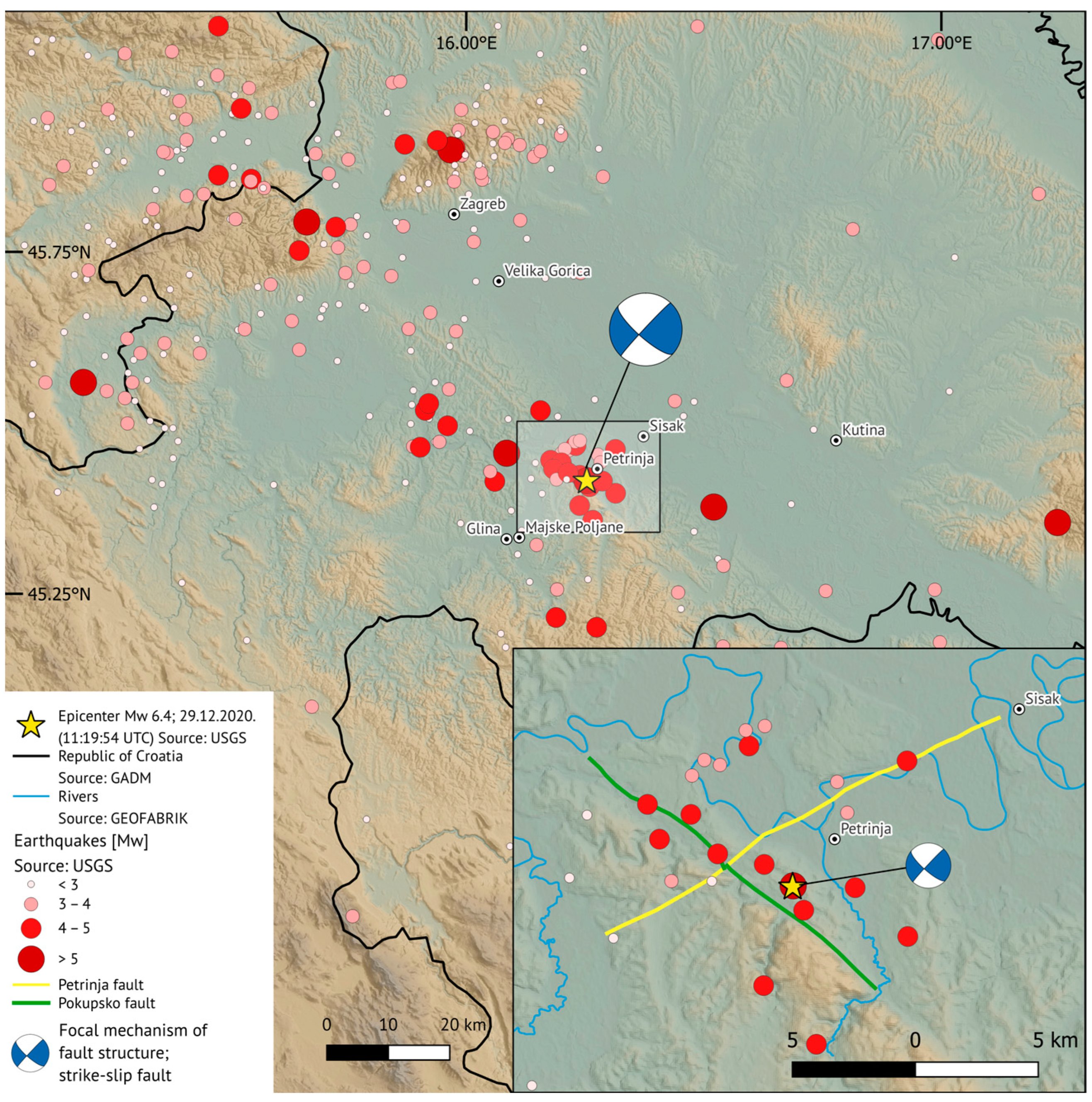
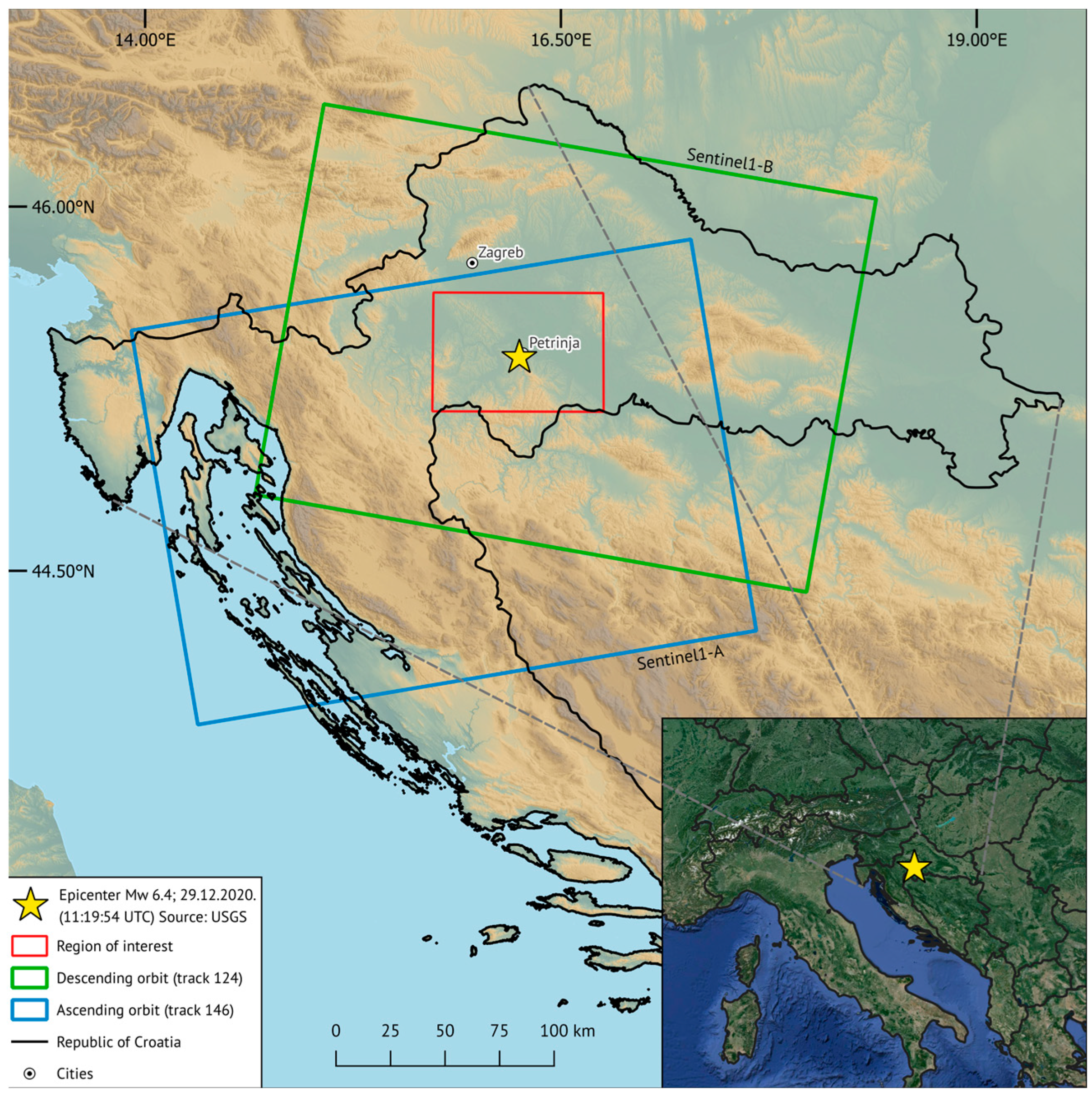
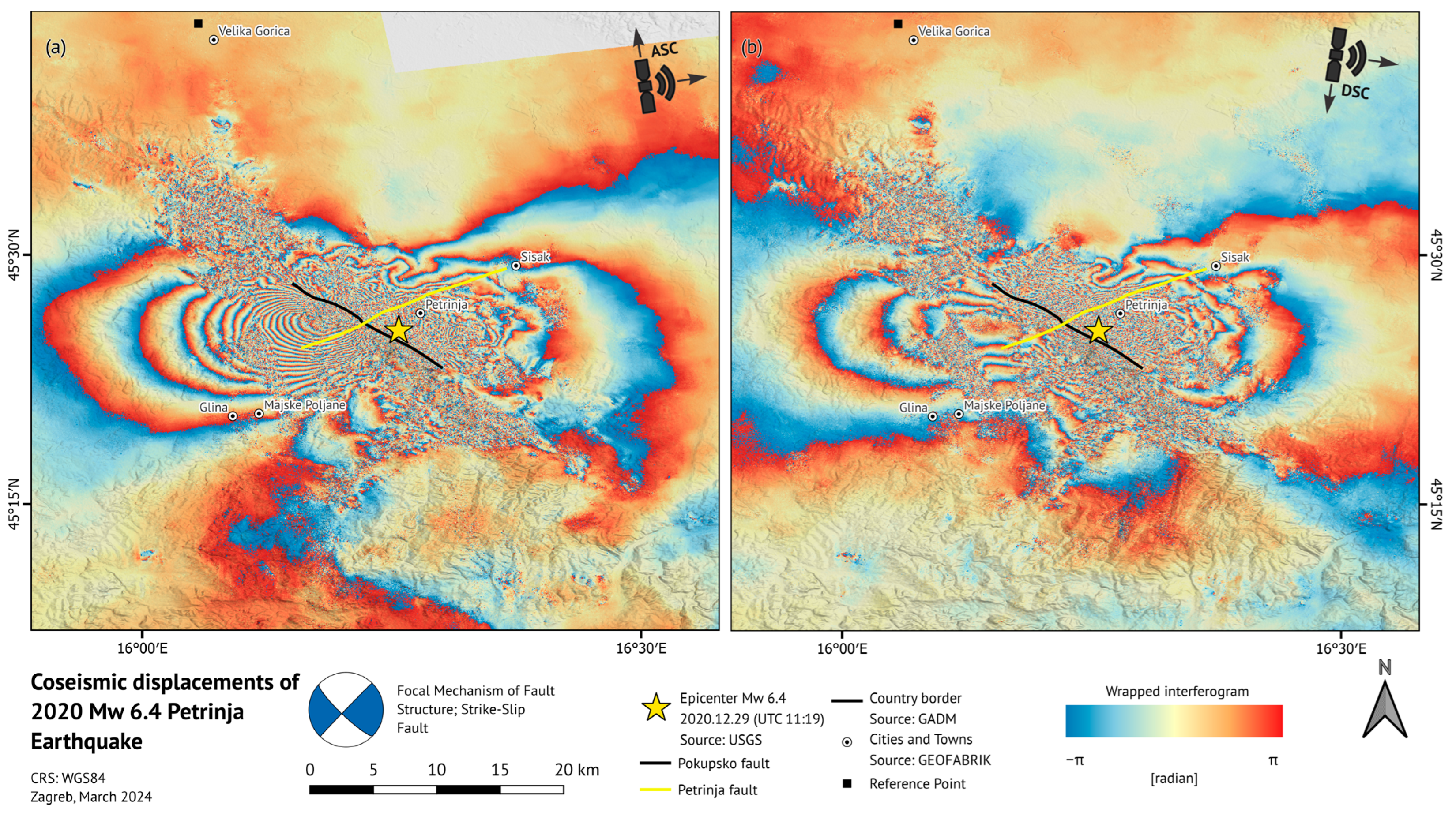
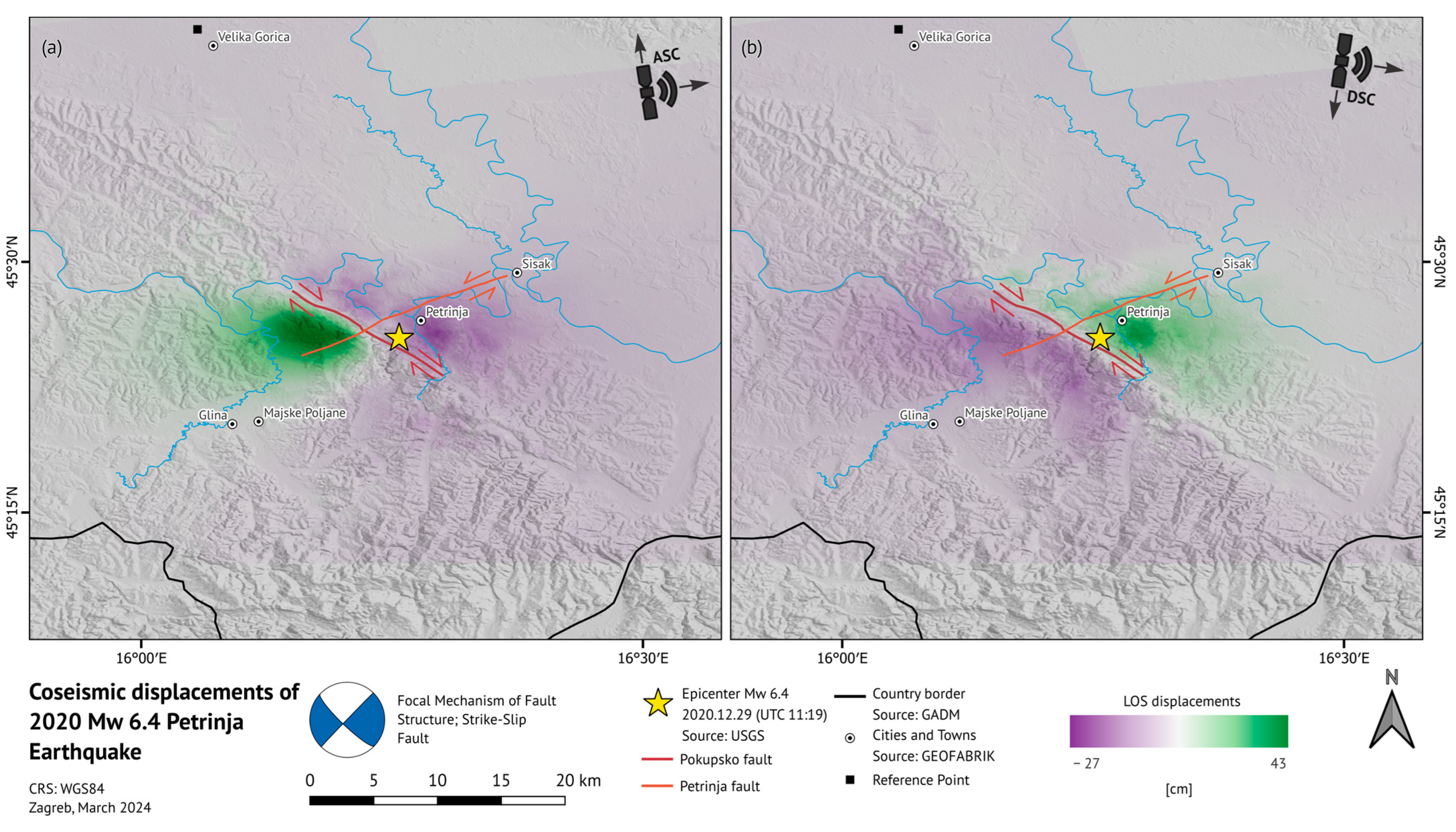
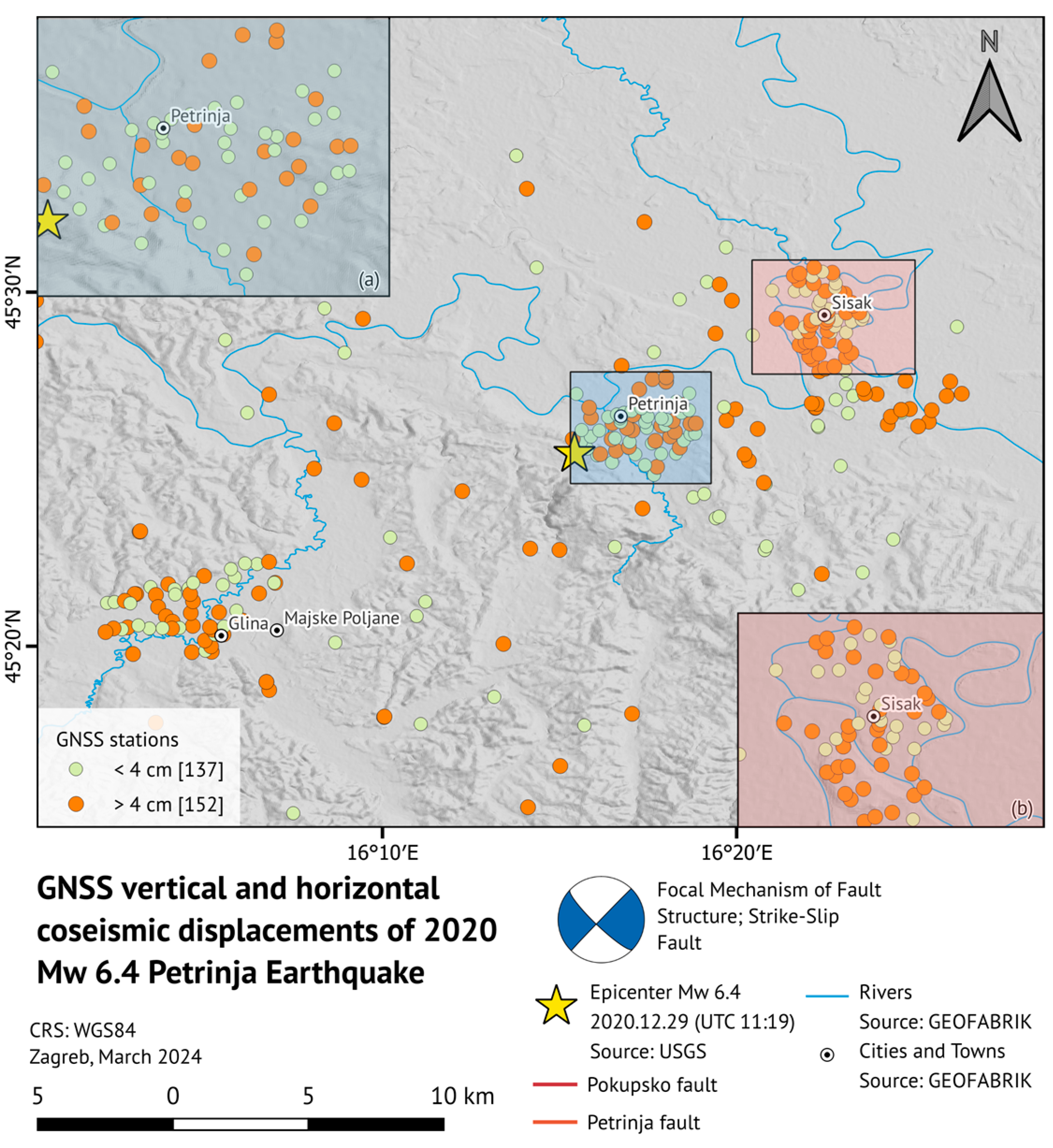

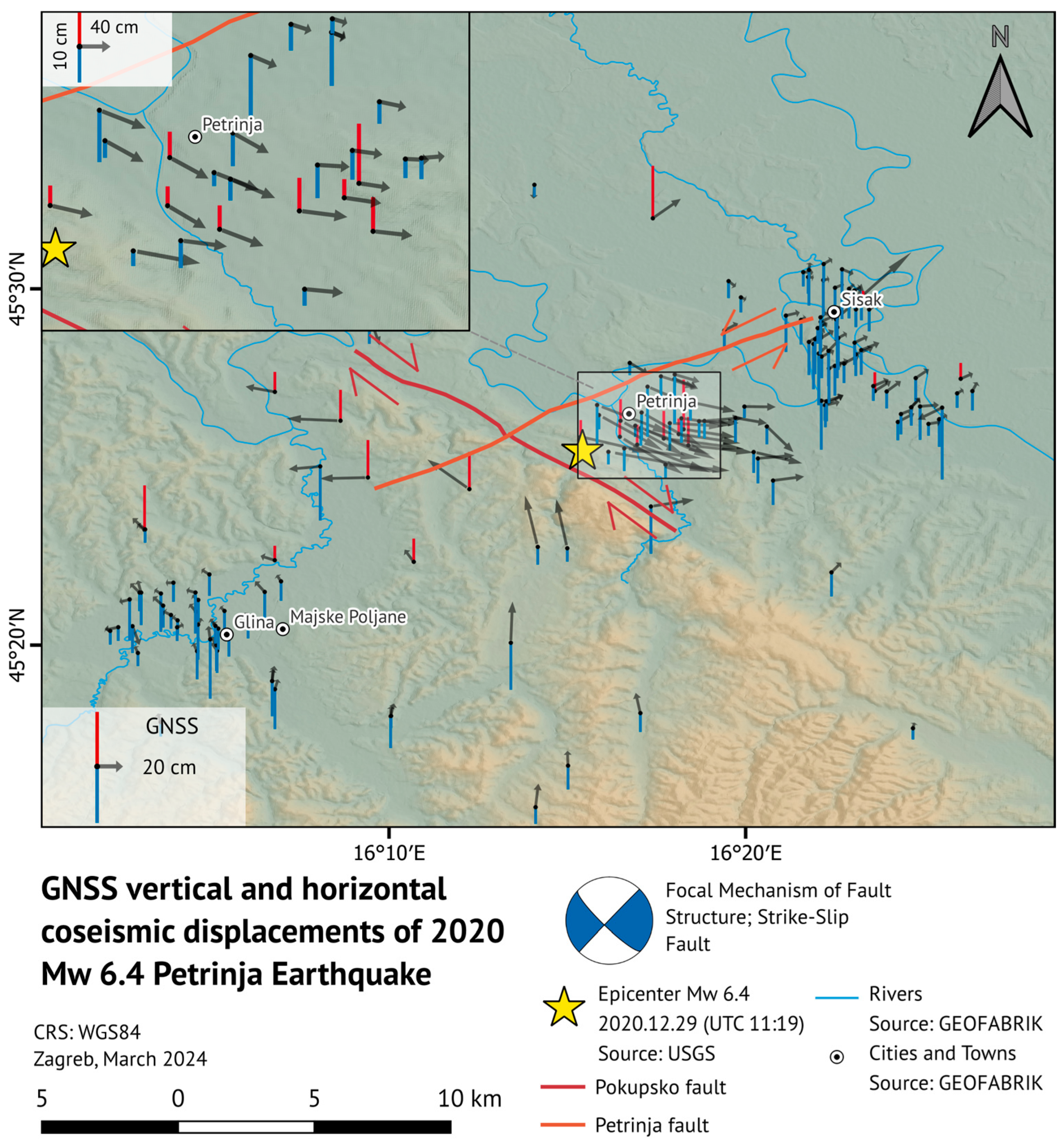
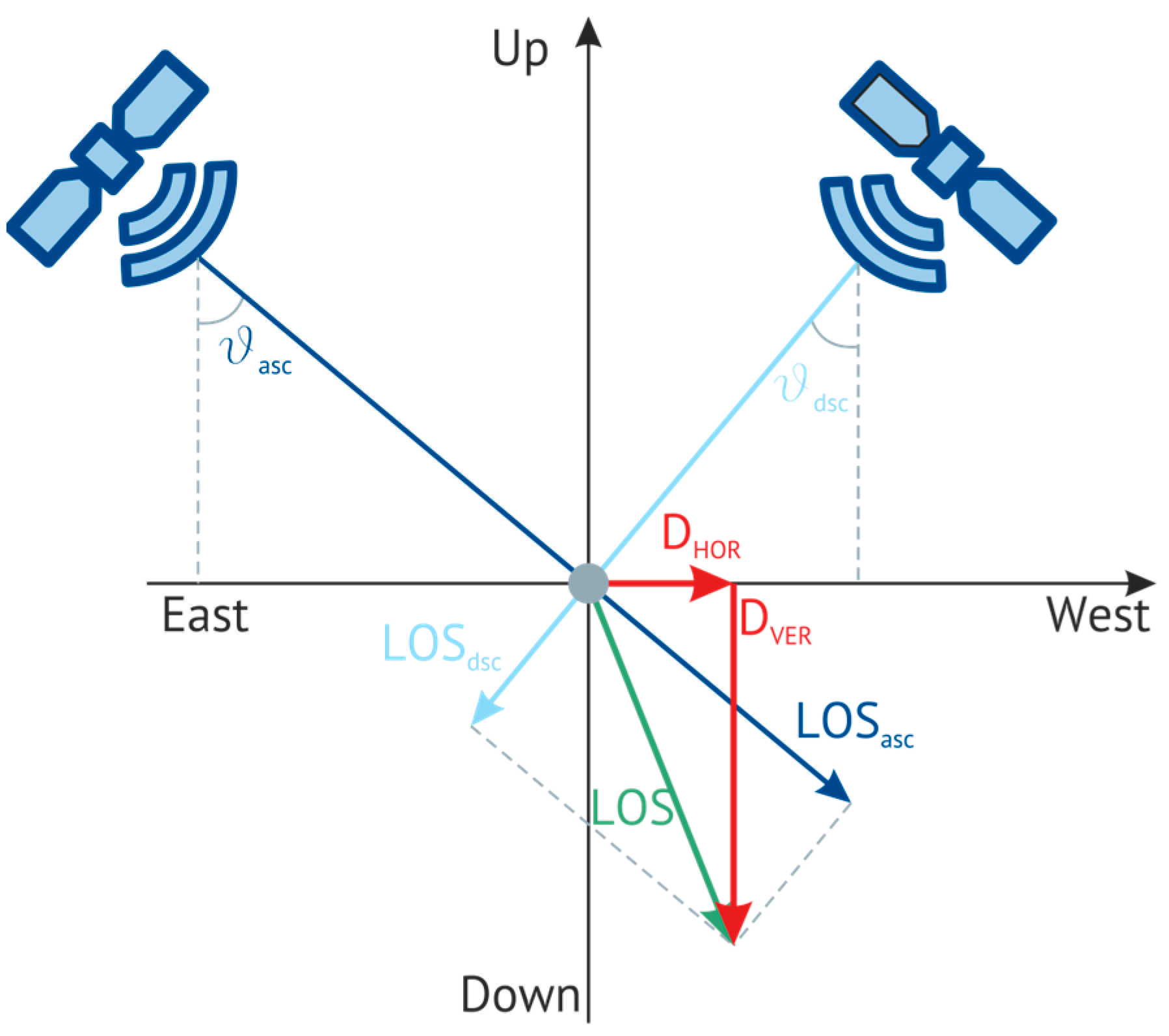
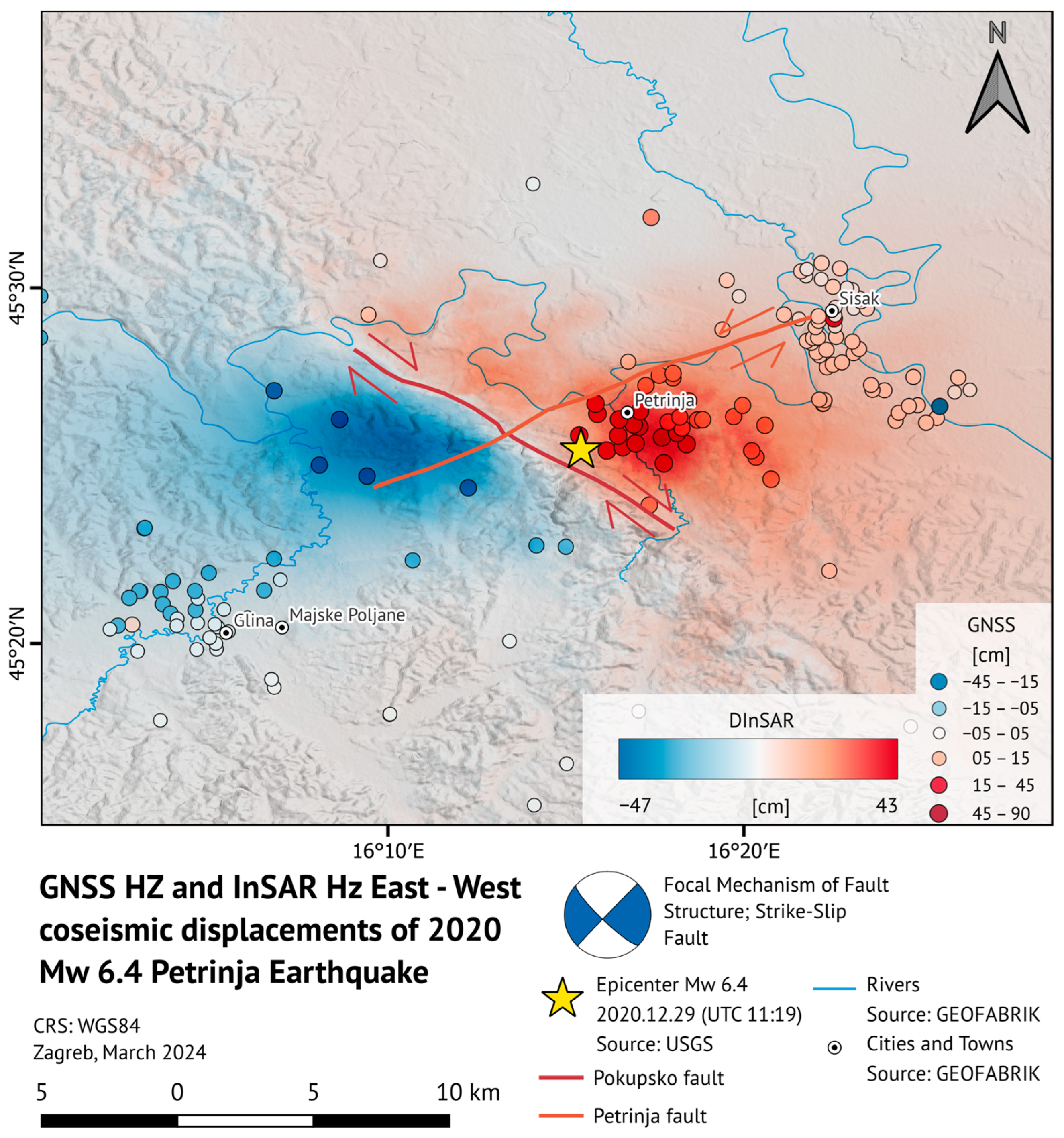
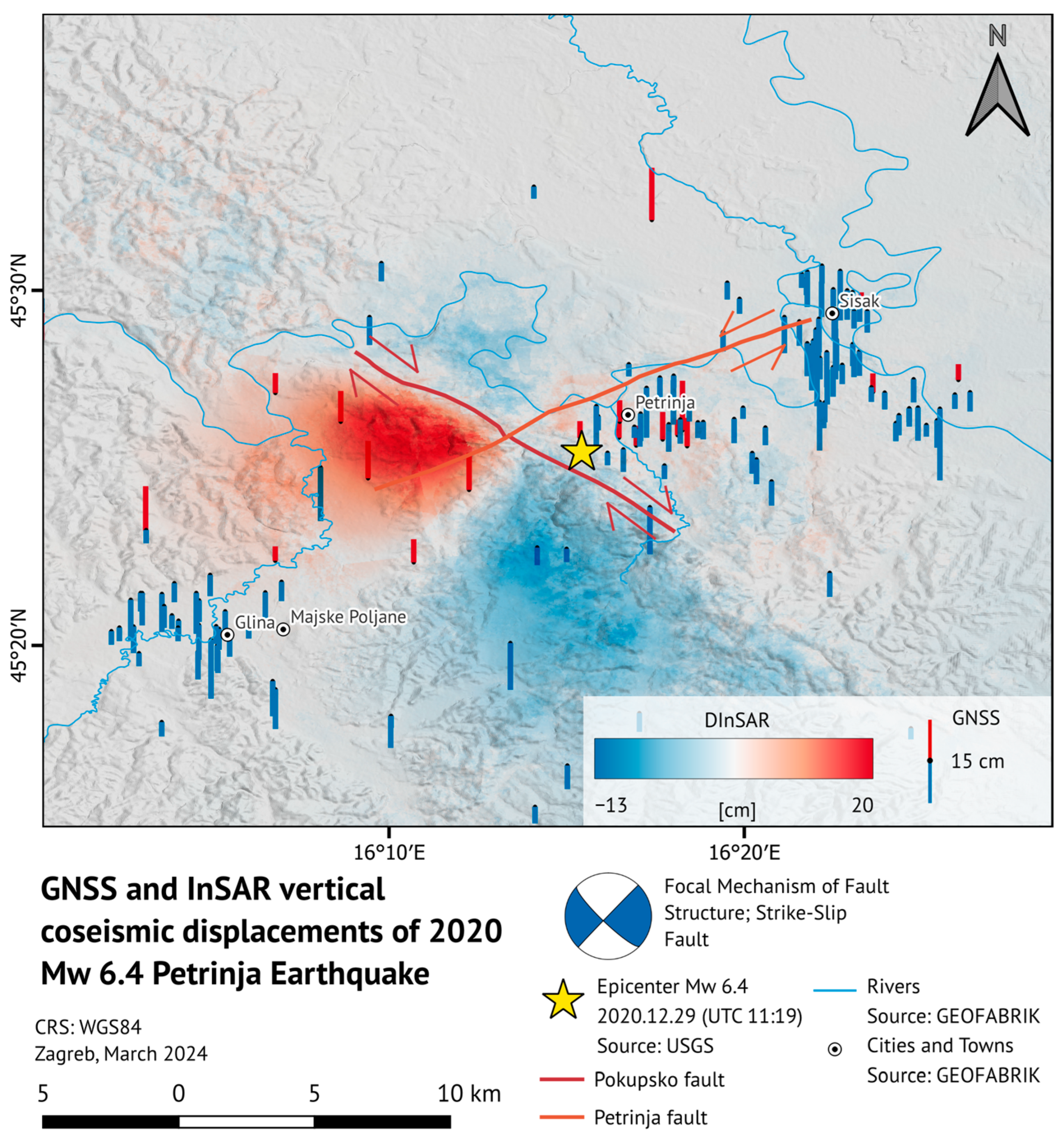
| No. | Date | Time [UTC] | Lat. Origin [°N] | Lon. Origin [°E] | Magnitude [Mw, ML, Mb] | Depth [km] | Strike [°] | Dip [°] | Rake [°] | Source 2 |
|---|---|---|---|---|---|---|---|---|---|---|
| 1 | 28 December 2020 | 05:25:07 | 45.441 | 16.188 | 4.77 Mw | 10 | 323 | 52 | 147 | USGS |
| 05:28:07 | 45.42 | 16.22 | 4.89 Mw | 10 | 254 | 72 | 33 | RCMT | ||
| 05:28:06 | 45.40 | 16.20 | 4.9 M | 10 | 328 | 81 | 136 | EMSC | ||
| 2 | 28 December 2020 | / | / | / | / | / | / | / | / | USGS |
| 06:49:56 | 45.42 | 16.28 | 4.55 Mw | 10 | 146 | 76 | −171 | RCMT | ||
| 06:49:57 | 45.40 | 16.10 | 4.6 M | 19 | 144 | 87 | −164 | EMSC | ||
| 3 | 29 December 2020 1 | 11:19:54 | 45.424 | 16.257 | 6.36 Mw | 13.5 | 224 | 89 | 14 | USGS |
| 11:19:54 | 45.42 | 16.21 | 6.42 Mw | 10 | 223 | 86 | 21 | RCMT | ||
| 11:19:54 | 45.40 | 16.20 | 6.4 M | 14 | 223 | 86 | 19 | EMSC | ||
| 4 | 30 December 2020 | / | / | / | / | / | / | / | / | USGS |
| 05:15:04 | 45.44 | 16.18 | 4.59 Mw | 10 | 309 | 72 | 109 | RCMT | ||
| 05:15:04 | 45.50 | 16.20 | 4.6 M | 10 | 306 | 73 | 107 | EMSC | ||
| 5 | 6 January 2021 | 17:01:43 | 45.432 | 16.242 | 4.72 Mw | 16 | 229 | 72 | 5 | USGS |
| 17:01:43 | 45.43 | 16.21 | 4.87 Mw | 8 | 46 | 87 | −15 | RCMT | ||
| 17:01:43 | 45.50 | 16.10 | 4.8 M | 15 | 50 | 78 | −4 | EMSC |
| Satellite | Orbit | Path/Frame | Leader Image | Follower Image | Bperp [m] | Btemp [Day] |
|---|---|---|---|---|---|---|
| Sentinel-1A | Ascending | 146/143 | 18 December 2020 | 30 December 2020 | 102.93 | 12 |
| Sentinel-1B | Descending | 124/441 | 23 December 2020 | 4 December 2021 | 55.69 | 12 |
| CROPOS Service | Solution Methods | Data Transfer | Data Format | Precision |
|---|---|---|---|---|
| DPS | Networked solution for real-time code measurements | Wireless Internet (UMTS, GPRS) NTRIP protocol | RTCM | 0.3–0.5 m |
| VPPS | Networked solution for real-time phase measurements | Wireless Internet (UMTS, GPRS) NTRIP protocolGSM | RTCM | 2 cm (3D) 4 cm (3D) |
| GPPS | Post-processing | Internet (FTP, e-mail) | RINEX | 1 cm (2D, 3D) |
| Statistics (n = 289) | ΔE [cm] | ΔN [cm] | Hz [cm] | ΔH [cm] |
|---|---|---|---|---|
| Minimum | −86.3 | −51.9 | 0.9 | 0.0 |
| Maximum | 41.9 | 30.7 | 87.8 | 26.3 |
| Average | 17.0 | 7.6 | 20.0 | 6.0 |
| St. deviation | 18.1 | 7.6 | 18.3 | 5.0 |
| Statistics (n = 152) | ΔE [cm] | ΔN [cm] | Hz [cm] | ΔH [cm] |
|---|---|---|---|---|
| Minimum | −86.3 | −51.9 | 4.4 | 4.1 |
| Maximum | 41.9 | 29.1 | 87.8 | 26.3 |
| Average | 15.3 | 8.0 | 18.8 | 9.1 |
| St. deviation | 17.1 | 8.1 | 17.4 | 4.3 |
Disclaimer/Publisher’s Note: The statements, opinions and data contained in all publications are solely those of the individual author(s) and contributor(s) and not of MDPI and/or the editor(s). MDPI and/or the editor(s) disclaim responsibility for any injury to people or property resulting from any ideas, methods, instructions or products referred to in the content. |
© 2024 by the authors. Licensee MDPI, Basel, Switzerland. This article is an open access article distributed under the terms and conditions of the Creative Commons Attribution (CC BY) license (https://creativecommons.org/licenses/by/4.0/).
Share and Cite
Pavasović, M.; Babić, D.; Banko, A.; Timár, G. The Largest Geodetic Coseismic Assessment of the 2020 Mw = 6.4 Petrinja Earthquake. Remote Sens. 2024, 16, 2112. https://doi.org/10.3390/rs16122112
Pavasović M, Babić D, Banko A, Timár G. The Largest Geodetic Coseismic Assessment of the 2020 Mw = 6.4 Petrinja Earthquake. Remote Sensing. 2024; 16(12):2112. https://doi.org/10.3390/rs16122112
Chicago/Turabian StylePavasović, Marko, Drago Babić, Antonio Banko, and Gábor Timár. 2024. "The Largest Geodetic Coseismic Assessment of the 2020 Mw = 6.4 Petrinja Earthquake" Remote Sensing 16, no. 12: 2112. https://doi.org/10.3390/rs16122112
APA StylePavasović, M., Babić, D., Banko, A., & Timár, G. (2024). The Largest Geodetic Coseismic Assessment of the 2020 Mw = 6.4 Petrinja Earthquake. Remote Sensing, 16(12), 2112. https://doi.org/10.3390/rs16122112











